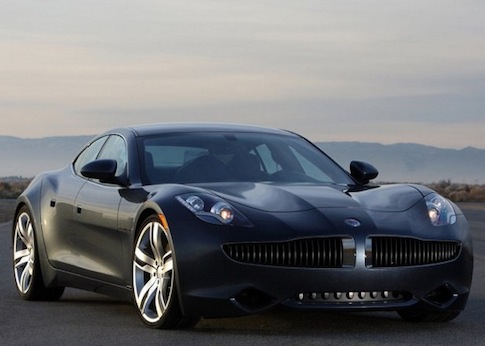The collapse of a government-subsidized battery manufacturer has caused the production of a government-subsidized electric car company to halt, raising questions about the government’s decision to support the two companies.
Fisker Automotive makes an extended-range electric luxury car called the Karma. It received approval for a government loan totaling $529 million in 2010.
The Karma uses a battery pack made by A123 Systems, which received a grant from the Department of Energy in 2009. A123 filed for bankruptcy in October, leaving Fisker, at least temporarily, without a battery manufacturer.
Fisker has suspended production of the Karma until A123’s sale is complete.
Meanwhile, documents obtained by the Washington Free Beacon indicate Fisker has its own financial issues.
A credit report prepared by the Department of Energy and dated Dec. 12, 2011, listed the "recovery rate" at 50 percent, indicating the government did not anticipate recovering the entirety of its loan to Fisker. The credit report also noted Fisker’s weakening credit rating, which declined from CCC+ to CCC due to its "deteriorating financial profile and/or persistent operational inefficiencies."
The report notes that Fisker failed to meet previously agreed-to milestones, causing the government to suspend the remainder of Fisker’s loan. Fisker had received $193 million from the government by this point, according to Fisker spokesman Roger Ormisher, and has not received the remainder of the loan total since.
But the Department of Energy had reason to worry even before then. An internal email dated Feb. 26, 2010—almost two months before the department announced Fisker’s finalized loan—says Fisker was "undercollateralized."
Another email dated Aug. 23, 2009, shows just how desperate Fisker was for the loan from the Department of Energy.
"We need the approval for Karma or for Karma and Kx in a very short timeframe. A delay until the end of September is not possible for us or our suppliers," wrote Fisker chief operating officer Bernhard Koehler, who also noted that he was laying off people from the company.
"This is hurting me a lot (personally and business related)," he wrote, "and is giving our competition (Tesla included) a huge advantage."
A123 added to Fisker’s woes when it recalled many of their batteries, including the ones manufactured for the Karma. Consumer Reports gave the Karma a failing grade in September, in part because of the car’s battery troubles.
The recall cost A123 $50 million, according to the Christian Science Monitor, and contributed to its bankruptcy.
Fisker does not have a battery manufacturer now that A123 is bankrupt. It will restart manufacturing once A123’s sale is finalized and it is able to renegotiate with A123’s new owner, according to Yahoo! News.
Ormisher said the Fisker Karma could only use A123’s battery as Fisker contracted with A123 to design and build the custom battery. He said it would take Fisker and a new company 12 to 14 months to reengineer a new battery for the Karma.
He said that Fisker was not worried about A123’s business model when it was first negotiating with them. He indicated that there were only a few choices for battery manufacturers and that while Fisker had an issue with A123’s battery cell manufacturing, the two companies otherwise had a good relationship.
"We’re hoping to have the same sort of relationship with the new owner," he said.
Ormisher said that Fisker was "absolutely" a viable company even without the Department of Energy loan in contrast to the tone in Koehler’s 2009 email.
Ormisher argued that the "substantial private interest" and financial investment that Fisker has attracted—to the tune of $1.2 billion—demonstrated Fisker’s viability.
"The loan helped us get Karma going," he said.
Fisker has produced a new car from scratch using new technology, creating the only luxury, extended-range electric vehicle in less than four years, Ormisher said, noting that it normally takes companies five to six years to do the same.
The luxury car costs around $100,000 and gets around 300 miles per tank of gas. (The gas-powered engine acts as a generator and charges the battery. The battery alone takes the car 50 miles.)
"We hope to be judged by what we’ve achieved," he said.
Others are less impressed with both the company’s performance and the government’s wisdom.
"Fisker Automotive’s struggles show us that taxpayer money has not been used to finance sound companies pursuing innovative technologies but rather has been used to prop up companies with operational problems and deteriorating financial conditions," said House Oversight Committee chairman Darrell Issa (R., Calif.).
A123’s bankruptcy is not the first time that a government-subsidized company has collapsed and hurt another government-subsidized company.
The company Prologis received a $1.4 billion partial loan guarantee for its Project Amp from the Department of Energy in September 2011. Solyndra’s collapse delayed Project Amp, however, raising concerns among Republican lawmakers of favoritism within the Energy Department for Solyndra.
William Yeatman, an energy expert at the Competitive Enterprise Institute, described the Obama administration’s funding of green energy companies as "vertical monopoly-type subsidy."
A vertical monopoly, he said, is where a company owns an entire industry’s supply and production chain. He said that the government, under Obama, has subsidized the entire green industry, from suppliers of car parts, to manufacturers of the cars themselves, to buyers through tax credits for purchasing hybrids.
"We’ve never seen anyone try to go from A to Z and plan out an industry," Yeatman said. "The history of government creating industries is one of unmitigated failure."
Issa agreed that the administration’s attempt to subsidize the entire green energy industry was failing.
"Attempts to create an artificial green economy have instead created a ‘house of cards’ economy," said Issa. "Taxpayers subsidized supplier companies both with direct infusion of cash and by subsidizing vehicle manufacturers to create artificial demand for their subsidized supplies."
The Department of Energy did not return requests for comment.
